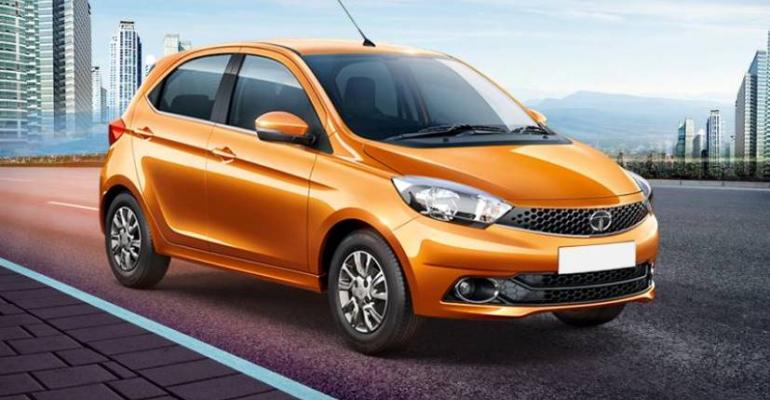MUMBAI – From shaking up top management, refreshing an aged product lineup and renaming a new car so it doesn’t suggest an untreatable virus, Tata is trying to dig itself out of a largely self-dug hole.
India’s No.3 automaker, knocked out of second place in 2014 by Hyundai, recorded 302,825 light-vehicle sales last year, according to WardsAuto data. Deliveries peaked in 2012 at 667,626 only to drop 30% year-over-year in both 2013 and 2014, then slip 7% in 2015.
Tata launched no new models between 2012 and 2015, but last year’s introduction of the Zest compact sedan and Bolt premium hatchback (not to be confused with Chevrolet’s upcoming all-electric sedan) raised car sales 18.4%. That slowed the yearly decline to 7%, but deliveries of the light trucks representing 60% of the automaker’s 2015 product mix fell 18.4%.
Tasked with turning around Tata’s sales slide, among other problems, is Guenter Butschek, named in January by the automaker as CEO and managing director. The 55-year-old previously served as chief operating officer of aircraft manufacturer Airbus and as president and CEO of Beijing Benz Automotive, a Chinese joint venture between Daimler and Beijing Automotive Industrial Holding.
Butschek will head all Tata operations in India and international markets including South Korea, Thailand, Indonesia and South Africa. He is the automaker’s first managing director since Karl Slym, who died in 2014.
Tata, meanwhile, is looking to hire a new chief financial officer, a position that has been vacant for more than two years. That person will have to slow, if not reverse, debt that inflated 270% over a decade to Rs736 billion ($11.3 billion) and an interest burden that ballooned 510% to Rs49 billion ($754 million).
The burgeoning debt and interest costs, which accumulated while Tata revenue was increasing tenfold over the same period, forced the automaker to withhold its fiscal 2015 dividend payments.
“It does not give me any pleasure to deny your rightful dividend,” Chairman Cyrus Mistry told shareholders Tata’s annual general meeting. “But I request you to look at the finances of the company and also to look for the long term. We have to make some sacrifices for the good of our company.”
Working Out Bugs, Viruses
Butschek’s top two lieutenants are Mistry and Mayank Pareek, president of Tata’s car division, who have kept Tata running since Slym’s death.
Tata already has adopted Mistry’s HorizoNext plan to achieve world-class manufacturing, better financial management and global quality. A dozen new or refreshed models are set for launch between now and 2018, beginning with the new Kite-4 hatchback and Kite-5 sedan, Hexa CUV and Nexon compact SUV.
One rollout delivered an unexpected shock to Tata. A new CUV called the Zica was to go to market immediately after the Auto Expo in Delhi in early February – while the untreatable Zika virus was gaining momentum among populations in Central and South America and some Pacific Islands. After holding a contest on social media Tata announced Feb. 22 it had renamed the car the Tiago.
Mistry has initiated development of a new modular platform to be used on all future models. Its flexibility allows modules to be changed inexpensively for every new design, lowering design and production costs and saving time on both counts.
The chairman is able to draw upon Tata’s technical center in Coventry, U.K., and design studio in Turin, Italy. But its highly successful, wholly owned Jaguar Land Rover subsidiary has resisted sharing technologies, saying they are different for luxury cars.
Pareek, meanwhile, is revising market segments and repositioning models in a bid to regain lost customers and bring in new ones. For the first time in several years, he has new products to work with.
The outdated Indica and Indigo were not competitive in urban markets and were relegated to rural areas, fleet sales or sold to taxi drivers. Pareek has halted sales of Tata cars to fleets and taxi owners as he seeks to restore the brand’s value.
Aware that Tata sales also were sliding as a result of poor quality, obsolete technology and indifferent aftersale service, Pareek is acting to ensure improvements on all three fronts.
Tata also is changing its pricing policy for new models after determining their relatively high price was one reason for the slow consumer response to the Zest and Bolt.
Tata plans to grow its network of dealers from 460 to 1,500 over the next four years. While that will leave the automaker behind market leader Maruti Suzuki’s 4,000-plus retail outlets and Hyundai’s more than 2,000, Pareek is deploying more than 1,000 mobile service vans to reach out to customers primarily in the country’s largely rural interior.





